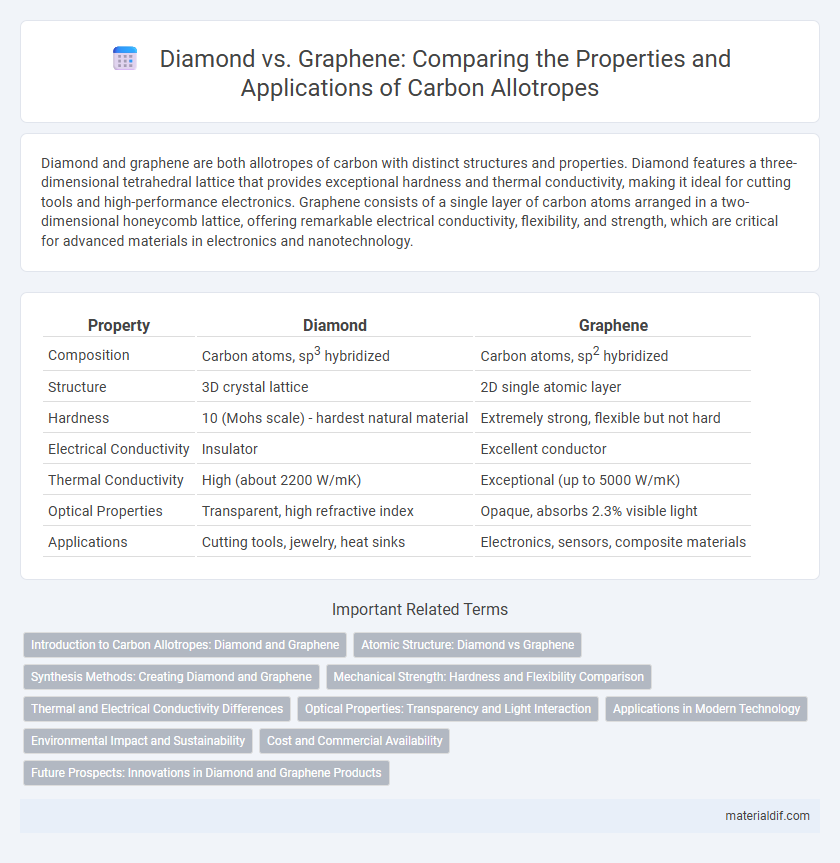Diamond and graphene are both allotropes of carbon with distinct structures and properties. Diamond features a three-dimensional tetrahedral lattice that provides exceptional hardness and thermal conductivity, making it ideal for cutting tools and high-performance electronics. Graphene consists of a single layer of carbon atoms arranged in a two-dimensional honeycomb lattice, offering remarkable electrical conductivity, flexibility, and strength, which are critical for advanced materials in electronics and nanotechnology.
Table of Comparison
| Property | Diamond | Graphene |
|---|---|---|
| Composition | Carbon atoms, sp3 hybridized | Carbon atoms, sp2 hybridized |
| Structure | 3D crystal lattice | 2D single atomic layer |
| Hardness | 10 (Mohs scale) - hardest natural material | Extremely strong, flexible but not hard |
| Electrical Conductivity | Insulator | Excellent conductor |
| Thermal Conductivity | High (about 2200 W/mK) | Exceptional (up to 5000 W/mK) |
| Optical Properties | Transparent, high refractive index | Opaque, absorbs 2.3% visible light |
| Applications | Cutting tools, jewelry, heat sinks | Electronics, sensors, composite materials |
Introduction to Carbon Allotropes: Diamond and Graphene
Diamond and graphene are two distinct carbon allotropes with unique atomic structures; diamond features a three-dimensional tetrahedral lattice of sp3-hybridized carbon atoms, resulting in exceptional hardness and thermal conductivity. Graphene consists of a single layer of sp2-hybridized carbon atoms arranged in a two-dimensional hexagonal lattice, offering extraordinary electrical conductivity and mechanical strength. These structural differences underpin their diverse applications in electronics, optics, and materials science.
Atomic Structure: Diamond vs Graphene
Diamond features a three-dimensional tetrahedral lattice where each carbon atom forms strong covalent bonds with four neighbors, resulting in exceptional hardness and rigidity. Graphene consists of a single layer of carbon atoms arranged in a two-dimensional hexagonal lattice with sp2 hybridization, providing outstanding electrical conductivity and flexibility. The difference in atomic structure explains diamond's insulating properties and graphene's high electron mobility.
Synthesis Methods: Creating Diamond and Graphene
Diamond synthesis predominantly employs high-pressure high-temperature (HPHT) and chemical vapor deposition (CVD) methods, where carbon atoms are crystallized under extreme conditions to form a rigid tetrahedral lattice. Graphene production typically utilizes chemical vapor deposition on metal substrates or mechanical exfoliation from graphite, enabling single-layer carbon sheets with hexagonal lattices. Both materials rely on precise control of temperature, pressure, and carbon source to achieve their distinct atomic structures and superior material properties.
Mechanical Strength: Hardness and Flexibility Comparison
Diamond exhibits exceptional hardness due to its rigid three-dimensional carbon atom lattice, making it the hardest known natural material. Graphene, composed of a single layer of carbon atoms arranged in a two-dimensional honeycomb lattice, boasts remarkable flexibility and tensile strength, surpassing steel in strength per unit weight. The contrast between diamond's unmatched hardness and graphene's superior flexibility highlights their unique mechanical properties tailored for distinct industrial applications.
Thermal and Electrical Conductivity Differences
Diamond exhibits exceptional thermal conductivity of approximately 2200 W/m*K, making it one of the best thermal conductors due to its strong covalent bonding and rigid lattice structure. In contrast, graphene demonstrates superior electrical conductivity, with electron mobility exceeding 200,000 cm2/V*s, attributed to its two-dimensional structure and delocalized p-electrons. While diamond is an electrical insulator, graphene's exceptional electron transport properties enable applications in high-speed electronics and thermal management.
Optical Properties: Transparency and Light Interaction
Diamond exhibits exceptional optical properties due to its high refractive index and strong light dispersion, resulting in remarkable brilliance and transparency across the visible spectrum. Graphene, a single layer of carbon atoms, is nearly transparent, absorbing only about 2.3% of visible light, making it highly suitable for optoelectronic applications requiring minimal light interference. The contrast in light interaction between diamond's dense, three-dimensional lattice and graphene's two-dimensional structure defines their unique roles in photonics and transparent conductive materials.
Applications in Modern Technology
Diamonds exhibit exceptional hardness and thermal conductivity, making them ideal for cutting tools and heat sinks in electronics. Graphene's unparalleled electrical conductivity and flexibility drive advancements in flexible displays, sensors, and energy storage devices. Both materials leverage carbon's unique properties to revolutionize modern technology across diverse industries.
Environmental Impact and Sustainability
Diamond mining often involves significant environmental degradation, including habitat destruction, water pollution, and high carbon emissions due to energy-intensive extraction processes. Graphene production, especially via green synthesis methods like plant-based precursors or low-energy chemical vapor deposition, presents a more sustainable alternative with lower environmental footprints and greater scalability. The shift toward graphene in industries capitalizes on its exceptional strength, conductivity, and reduced ecological impact, promoting sustainable innovation in materials science.
Cost and Commercial Availability
Diamonds are significantly more expensive due to their rarity and the complex mining processes required, whereas graphene, derived from graphite, is more affordable and commercially scalable through chemical vapor deposition and exfoliation methods. The commercial availability of diamond remains limited mostly to jewelry and industrial cutting tools, while graphene's widespread use spans electronics, composites, and energy storage. Economical production methods continue to boost graphene's market presence, making it more accessible for diverse technological applications compared to diamonds.
Future Prospects: Innovations in Diamond and Graphene Products
Diamonds and graphene are poised to revolutionize industries with groundbreaking innovations; diamond-based semiconductors promise enhanced durability and thermal conductivity for electronics, while graphene's exceptional strength and electrical conductivity drive advancements in flexible displays, batteries, and sensors. Research in diamond quantum computing aims to harness nitrogen-vacancy centers for robust qubits, whereas graphene's role in developing ultra-fast transistors and next-generation energy storage devices highlights its transformative potential. Commercialization of diamond coatings and graphene composites is accelerating, signaling a future where these carbon allotropes sustainably improve technology performance and energy efficiency.
Diamond vs Graphene Infographic

 materialdif.com
materialdif.com